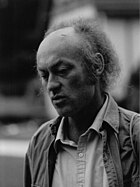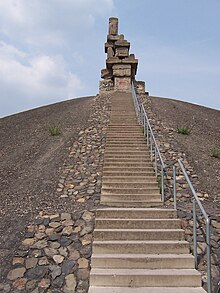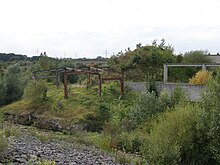Herman Prigann
Herman Prigann (born July 19, 1942 in Recklinghausen ; † December 9, 2008 in Portals Nous ) was a German visual artist of land art and ecology .
Life
From 1963 to 1968 Prigann studied painting and urban planning at the Hamburg University of Fine Arts . In 1965 he founded the artist group Cruizin 4 (syndicate for the art business) in Hamburg with Gunter Gerlach , Dieter Glasmacher , Werner Nöfer and Dirk Zimmer (Dizi) . Immediately after graduating, Prigann began realizing a large number of projects in action art and performing arts .
Since 1974 Herman Prigann lived in Portals Nous on Mallorca .
After the fall of the Wall , Prigann was one of the initiators of the 1st Symposium in 1991 in the former Greifenhain open- cast lignite mine near Altdöbern . Together with the event organization Förderverein Kulturlandschaft Niederlausitz eV under the direction of Heinrich Schierz, Herman Prigann made organizational contributions as well as his artistic final campaign Feuerlinie .
At the III. Europa Biennale Niederlausitz 1995 Prigann was able to participate with his project “ Yellow Ramp ”, which he had started in 1993 during the II. Europa Biennale.
From 1994 to 1998 Prigann was an employee of Rolf Kuhn , the then director of the Bauhaus Dessau Foundation .
Herman Prigann was married. The daughters Aisha, Alice May and Jennifer come from the marriage. Together they run a retrospective on the Internet.
position

In his work, Prigann dealt with questions of environmental design, spatial development and the conversion of old buildings (primarily industrial plants) from an ecological point of view. His works always have a local reference and are in part attempts to come to terms with the past. Prigann worked on an international level, but most of the projects are in Germany.

The artist worked with natural materials such as tree trunks, stones and sand. It was important to him that the material used has a connection to the respective place, comes from there or is linked to the story. In his projects in the Ruhr area , he therefore preferred to use waste materials from the industrial age such as old pieces of wall, concrete blocks and steel parts.
In addition to his technically complex large-scale projects, Prigann also valued the spontaneous, playful work with materials found in nature such as leaves, twigs, flowers, etc. In order to convey this simple form of natural art, Prigann occasionally offered weekend seminars.
Projects (selection)
Sculpture forest Rheinelbe in Gelsenkirchen
The redesign of the Rheinelbe dump in Gelsenkirchen-Ückendorf is an outstanding example of Prigann's work. He realized a number of large and small sculptures here as part of the IBA Emscherpark . The best known is the Himmelstreppe , which, made of mighty concrete blocks, stands on the highest point of the heap. It belongs to the series of landmarks in the Ruhr area. Also on the site of the former colliery, Prigann realized his sculpture “hanging woods / balance” in the switching house, which was impressively complemented by the sound installation “technical nature” by Honke Rambow .
Debris field at the Mont Cenis colliery
Set pieces of old industrial buildings in the Ruhr area such as wall sections, foundation blocks and pillars are arranged in a field of stelae that contrasts with the modern architecture of the academy north of the academy Mont-Cenis in Herne .
Circle of Remembrance (1992-1993)
A large circle made of tree trunks and other natural materials marks the former German-German border in the Harz Mountains. At the same time there is a reference to the belief in witch circles that is widespread in this area.
Other Projects
- Arbor Inversa on the Danube Island in Vienna
- Yellow Ramp , 1993–1995 in Pritzen (Niederlausitz)
- Museum of lost wishes , ideas for using closed landfills
- Redesign of the Mulde river bed on the Goitzsche in Bitterfeld
- The hill of contemplation (1996) in TICKON, Langeland, Denmark
- Ring of memories in the Sorge border museum
- Water levels , a landscape art project around the old, dilapidated Marl-Sickingmühle waterworks between the canal and the Lippe (2000).
literature
- Roland Günter, Janne Günter, Peter Liedtke: Industrial forest and landscape art in the Ruhr area. Klartext, Essen 2007, ISBN 978-3-89861-594-5 .
- Paula Llull: Herman Prigann and the Unfinished Ecology of Sculpture. In: Twylene Moyer, Glenn Harper (Eds.): The New Earthwork. Art, Action, Agency. University of Washington Press, 2012.
- Heike Strelow, Vera David: Ecological Aesthetics. Theory and practice of artistic environmental design. Basel Berlin Boston 2004, ISBN 3-7643-2423-6 .
- Udo Weilacher: In the mad dance of entropy and evolution - Herman Prigann. Interview. In: Udo Weilacher: Between landscape architecture and land art. Basel Berlin Boston 1999 ISBN 3-7643-6120-4 .
Web links
- Literature by and about Herman Prigann in the catalog of the German National Library
- Homepage Herman Prigann.
- Herman Prigann - video channel on www.vimeo.com
- Kai Ehlers and Jefim Berschin: In between.
- Museum of Lost Desires
- Thoughts about "Art in Nature" - Article by Herman Prigann (English)
Individual evidence
- ^ Förderverein Kulturlandschaft Niederlausitz eV (Ed.): Art scene opencast mining. Edition Braus, Heidelberg 1992, p. 80f.
- ^ Förderverein Kulturlandschaft Niederlausitz eV (Ed.): Art scene opencast mining. Edition Braus, Heidelberg 1992, p. 18f.
- ↑ Friends of the Niederlausitz Cultural Landscape (ed.): III. Europe Biennale Niederlausitz. Cottbus (1997), p. 48f.
- ^ Förderverein Kulturlandschaft Niederlausitz eV (Ed.): II. Europa Biennale Niederlausitz. Niederlausitz Edition, Cottbus 1994, pp. 67-69.
- ↑ Wolfgang Berke: Over all mountains - The definitive stockpile guide in the Ruhr area. Klartext Verlag, Essen 2009, ISBN 978-3-8375-0170-4 , p. 102 (Quote: The ensemble is called "Himmelstreppe" )
| personal data | |
|---|---|
| SURNAME | Prigann, Herman |
| BRIEF DESCRIPTION | German landscape artist |
| DATE OF BIRTH | July 19, 1942 |
| PLACE OF BIRTH | Recklinghausen |
| DATE OF DEATH | December 9, 2008 |
| Place of death | Portals Nous |



